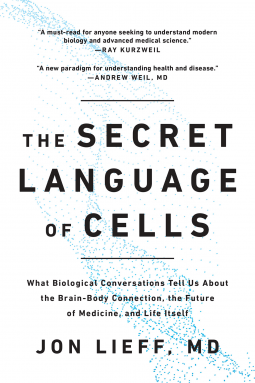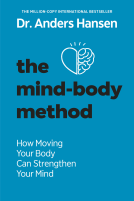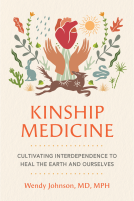
The Secret Language of Cells
What Biological Conversations Tell Us About the Brain-Body Connection, the Future of Medicine, and Life Itself
by Jon Lieff
This title was previously available on NetGalley and is now archived.
Send NetGalley books directly to your Kindle or Kindle app
1
To read on a Kindle or Kindle app, please add kindle@netgalley.com as an approved email address to receive files in your Amazon account. Click here for step-by-step instructions.
2
Also find your Kindle email address within your Amazon account, and enter it here.
Pub Date Sep 22 2020 | Archive Date Oct 07 2020
Talking about this book? Use #TheSecretLanguageofCells #NetGalley. More hashtag tips!
Description
Right now, both your inner and outer worlds are abuzz with chatter among living cells of every possible kind—from those in your body and brain to those in the environment around you. From electrical alerts to chemical codes, the greatest secret of modern biology, hiding in plain sight, is that all of life's activity boils down to one thing: conversation.
While cells are commonly considered the building block of living things, it is actually the communication between cells that brings us to life, controlling our bodies and brains, determining whether we are healthy or sick, and directly influencing how we think, feel, and behave.
In The Secret Language of Cells, doctor and neuroscientist Jon Lieff lets us listen in on these conversations, and reveals their significance for everything from mental health to cancer. He explains the surprising science of how very different cells—bacteria and brain cells, blood cells and viruses—all speak the same language. This overarching principle has been long overlooked because scientific journals use impenetrable jargon that makes it hard to be understood across disciplines, much less by the general public.
Lieff presents a fascinating and accessible look into cellular communication science—a groundbreaking and comprehensive exploration of this biological phenomenon. In these pages, discover the intriguing lives of cells as they ask questions, get answers, give feedback, gather information, call for each other, and make complex decisions. During infections, immune T-cells tell brain cells that we should "feel sick" and lie down. Cancer cells warn their community about immune and microbe attacks. Gut cells talk with microbes to determine which are friends and which are enemies, and microbes talk with each other and with much more complicated human cells in ways that determine which medicines work and which will fail.
With applications for immunity, chronic pain, weight loss, depression, cancer treatment, and virtually every aspect of health and biology, cellular communication is revolutionizing our understanding not just of disease, but of life itself. The Secret Language of Cells is required reading for anyone interested in following the conversation.
A Note From the Publisher
PDF AVAILABILITY ONLY. Epub and Mobi files are not available at this time, so please note that there may be formatting issues if you read via Kindle.
Advance Praise
"Through a brilliant synthesis of cellular biology, microbiology, immunology and neuroscience, The Secret Language of Cells offers a lucid explanation of the marvelous intricacies of cellular life. The result is a tour-de-force exploration of the profound implications of cellular intelligence for understanding pathophysiology, human health and even our origins."
—William B. Miller, Jr., MD, physician, biologist, author of The Microcosm Within: Evolution and Extinction in the Hologenome, and internationally recognized expert on Cognition-Based Evolution
Available Editions
| EDITION | Other Format |
| ISBN | 9781948836043 |
| PRICE | $26.95 (USD) |
| PAGES | 320 |
Links
Featured Reviews
 David W, Media/Journalist
David W, Media/Journalist
If you think medicine is full of indecipherable jargon, imagine how Dr Jon Lieff feels. His book, The Secret Language of Cells, compiles 12 years of research into how the body knows what to do. He had to find needles in haystacks – mentions of signals emanating from cells – and piece together their significance himself. The result is the first book that assembles it all – and not just human bodies, but also plants. The conversations are mind boggling. The insights are groundbreaking. You will witness the birth of a new science.
What Lieff describes is an entire cosmopolitan society inside the body, with cops and bad guys, plotters, conspirators, terrorists, hostage takers, street gangs, fraudsters and Trojans. But also caretakers, gardeners, neighborhood watchers, guards, builders, shippers, receivers, inspectors, rescuers, bouncers, cleaners and monitors. There is national, regional and local government. And everyone is broadcasting in their own language, all the time. The whole society is on high alert, all the time. Everyone is a town crier. Overnight garbage crews clean up the mess from the day, and it all begins again in the morning. This is life in the human body.
Lieff systematically plows through the body, describing the various cells, molecules, proteins and viruses that have roles in the drama. Then he steps out way farther, because everything in the book is about how these components converse. And they do converse, ceaselessly. They warn of intruders, give directions on their location, ask for more or less help, order more or less production, and provide each other with goods and services. This is a completely different view of the body at work. It is striking, shocking, fascinating and eye-opening. It absolutely forces new ways of thinking.
Just one example is the creation of neurons in the brain. For decades it was standard, unassailable knowledge that the brain stopped producing neurons at an early age, say 20, and then just deteriorated. Lieff shows that with communications, monitoring cells order the building of new neurons to replace old ones that are worn and inefficient. The result is a clutch of fresh neurons that have been trained to assume the memories of the old ones, and even upgraded to accept more detail because they have been used and useful for so long. It’s respect and reward for seniority. This, Lieff says, is part of why the elderly can recite every little aspect of an event 70 years ago, but cannot remember what they had for lunch today. If that doesn’t change the way medicine looks at gerontology and neuropsychiatry, nothing will. The book is full of such revelations.
Cancers get a thorough look, and so do viruses, including the COVID-19 virus. Cancers, like viruses, use subterfuge to get past the guards and establish themselves. Cancers co-opt cells meant to kill them, turning them into zombies doing their bidding. They force the good cells to help them build and spread cancer. One of the ways they do it is by communicating as if they were the good guys, fooling the T cells. Once established they can fool other cells into providing transport or bloodlfow to build themselves up.
Viruses are possibly even more remarkable, because there is basically nothing to them. A seven gene virus like Ebola earns Lieff’s respect. Just one of its handful of proteins can do five different jobs damaging other cells, redirecting others, using the internal transport system to travel throughout the body undetected, preventing cells from attaching tags to it, and basically taking over completely. How one protein can accomplish five so very different tasks is as amazing to Lieff as it is to us.
Leprosy is unique in that it can turn cells back into stem cells that it can reprogram to do its damage. This is a holy grail of medicine, and after 3000 years of leprosy, we still don’t know how the virus does it. Viruses have been around so long that 8% of human DNA comes from viruses implanted there, Lieff says.
The body is filled with communication channels. Nanotubes allow cells to bypass local traffic and get where they’re supposed to be. Fluids like the cerebrospinal fluid connect the critical functions of the nerves in the spine with critical neurons across the brain with a superhighway of conductive fluid. Neurons in the brain can have has many as 100,000 connections – synapses - giving the brain a good ten thousand trillion possible connections, all of which are constantly reporting status and making decisions. There are more than a thousand kinds of neurons and astrocytes, showing specialization that medicine knows next to nothing about. Microglia, the only brain cells not physically connected, patrol and regulate. They determine things like the emotional response to pain. They signal differently according to diseases they encounter or experience or hear about. inflammation can turn them into aggressive immune cells, as everything that can, pitches in to the fight. There three types of glial cells (“glue” that sticks to other cells): astrocytes, the most common, microglia and myelin, which coats pathways and tubes. The quality and patterns laid down by myelin determine the connection and the speed of the pathway. It provides entries and exits to passing cells. It’s not just insulation as we have assumed for 200 years.
What has not been discovered is the central authority that prioritizes action. Every region seems to be responsible for itself. It reports, but doesn’t seem to take much in the way of orders from the brain. The brain’s main functions appear to lie in external ops like movement, the senses and the mind. The nuts and bolts of existence is apparently a local and regional affair.
Organs are built out by the cells themselves communicating. New cells move into place knowing where the edge must end up being, for example. They find out from the very cells they climb over to get to where they need to be. Cells needed for an emergency repair or to fend off an invasion can even travel upstream, clinging to the wall of an artery and swinging their way forward through the oncoming blood. The myelin lining allows them to exit where they need to. Astrocytes in the brain walk along arteries and squeeze them with their feet pads when fresh blood is needed, and also hold them back to prevent the wrong kind of residents from crossing the blood-brain barrier. Cells slap tags on other cells so they can be identified later. Killer T cells can clear out an invader and then order up a new memory/monitor cell at the location to instantly report any recurrence going forward. T cells can edit their own DNA, disguising themselves from invaders they recognize.
Cells create nets to float over invaders and trap them. Mitochondria dock at another organelle in the cell, endoplasmic reticulum, to converse and determine where they have to deliver energy, pickup supplies, or even shut down. Cells present pieces of microbes to T cells so the T cells can recognize them later and elsewhere. Everything has a supervisor and everything holds nothing back. Knowledge is power and power comes from constant communication.
Microbes are a constant threat. They can hide in cells, hijack cells, and jump into information sacs that certain cells use to report their status, and get a free ride to some other region, safely hidden from inspectors. But with microbes there is another issue. Some are allies. They produce vitamins and minerals out of food, carry out some critical process, or aid in healing. There are cancer meds that will not work unless the body has certain microbes producing certain compounds. Probiotics will play a larger and larger role going forward, Lieff says. Somehow, the body is able to discern the good ones from the bad ones, but we don’t seem to know how. Are good microbes acting with permission? Or do they sneak by the body’s defenses like other foreign bodies try to. How does the body know not to attack these microbes like it does to other foreign bodies?
But then, microbes can switch sides too. What starts out as useful can suddenly damage DNA or, inhibit repairs. It can aid cancer by preventing cell death or allow cells to grow without oxygen. Lieff says a good recipe for cancer is inflammation, obesity, and microbes which can be altered by fat to aid cancer.
At the end of the day (literally), neurons physically retreat – shrink back – allowing the body’s equivalent of street sweepers to clean up the mess – the dead and damaged, the misfolded proteins, the shreds and shards and the half eaten from the cerebrospinal fluid pathways. This critical role of sleep is part of the link between Alzheimer’s and lack of sleep, where amyloid plaques clutter up the brain.
The human body is not alone in harboring a cacophony of communication. Lieff says plants are just as chatty. They communicate with each other using aerial chemical releases and along fungal filaments. Internally, the signals come from water pressure and chemical and electrical signals. Plants invite beneficial microbes to help fix nitrogen, while attacking microbes that are parasitic. They can even grow tumors to physically push insect eggs off its leaves.
Trees signal carbon-eating bacteria through their roots. Root hairs curl up as an inviting entryway into the tree. It also prepares a space inside, protected by a membrane where it wants the bacteria to set up shop. And lights up the path to the new space for the bacteria to follow. The bacteria settle in for decades, a win-win co-operation.
The same process applies to fungi, which also connect different plants together with filaments that can spread for miles. These filaments allow plants to communicate both internally and externally throughout a forest.
Lieff has performed a remarkable service with this book. He puts in plain everyday language the horrific jargon, ten dollar words and abstruse mathematical formulas that modern medicine has become. He is totally focused on the communications. And his chapters are totally focused and tight. Readers will never get tired of one subject going on too long. The result is not just easy to read, but draws a compelling picture of an entire society within the human body as well as in plants.
Numerous times he stops to say things like but we don’t know why, or it is difficult to understand or we’ve barely begun to do the research on this relationship or ability. Because this book is the first of its kind. Lieff has basically started a whole new discipline he calls sociovirology. It raises a lot of questions, but it also opens huge new horizons and perspectives that medicine has not even considered in its hellbent reductionist plunge for a quick fix. Nothing works that way, and The Secret Language of Cells proves it.
David Wineberg
This was such a fascinating and entertaining read! It honestly wasn't what I was expecting at all, but that wasn't a bad thing. I am obsessed with biology and figured this book would be right up my alley and it was! This takes you on a trip inside the human body on a cellular level to discover the functions throughout. While I already find science to be intriguing, I think this book would also be fun for anyone taking a biology class as it really brings the subject to life and would with reinforcing various concepts and ideas. Very fun must-read for science buffs!
 Paul V, Reviewer
Paul V, Reviewer
This is quite interesting. No scientific knowledge required. Don't read this if you're seeking solutions to a cell-related health issue. But do read this if you're interested in learning more about the human body. It's very well written and includes some great photos.
I really appreciate the ARC for review!!
Jon Lieff's The Secret Language of Cells lucidly and honestly expounds on the current state of knowledge with respect to the way living cells communicate and operate. Covering a wide variety of issues, this book will supply a lot of new information to the lay reader. For example, T-cell "training" to attack only hostile microbes and neither friendly bacteria nor food in the digestive tract, the "wireless" chemical communication that supplements nervous system connectivity including in the fluid surrounding the brain, the sophisticated coordination of inflammatory responses, and the ways cancer cells and damaging viruses "fool" the body's many -layered defenses, will be fascinating topics for many readers to explore. Dr. Lieff also highlights the inspiring new potential applications in medicine for these new insights into cell behavior - for immune responses and autoimmune diseases, for cancer treatment, and even for psychiatry. With enormous respect for Lieff, I dare to offer this one critique: a little more visual explanation and/or massaged in personal narratives like case studies about how our new understandings of cells were discovered, as was done effectively in I Contain Multitudes, might be more engaging for non-medical professional readers. This would help break the monotony of the "there is also x cells that do y" composition. Still this subject is so interesting to the public now that librarians should recommend, especially to those that like Bryson's the Body, I Contain Multitudes, or the Secret Life of Trees. Thanks to Dr. Lieff for opening up more of our world and ourselves to understanding!
I decided to try this book out since Biology was by far my favorite back in High School.
For a non-med student or practitioner, this book was fairly easy to understand if you have at least remembered your Biology classes. I was surprised to like it and I really didn't get lost in all the explanation. It's a welcome change for me to have read this.
Readers who liked this book also liked:
Jodi Picoult; Jennifer Finney Boylan
General Fiction (Adult), Literary Fiction, Women's Fiction
Michael Greger, M.D., FACLM
Cooking, Food & Wine, Health, Mind & Body, Self-Help


















